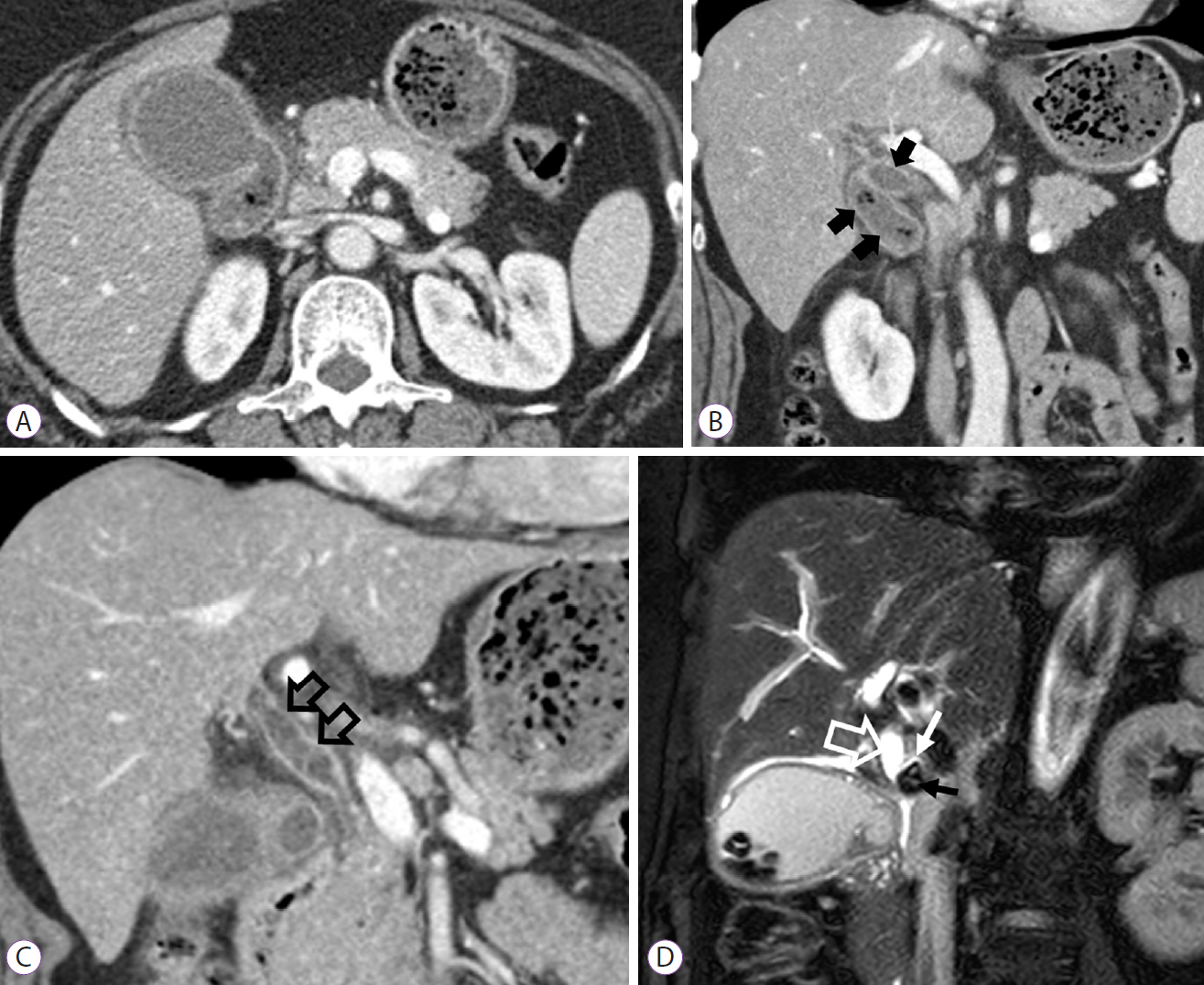Clin Endosc.
2021 Nov;54(6):930-934. 10.5946/ce.2021.015.
Minimally Invasive Approach Using Digital Single-Operator Peroral Cholangioscopy-Guided Electrohydraulic Lithotripsy and Endoscopic Nasogallbladder Drainage for the Management of High-Grade Mirizzi Syndrome
- Affiliations
-
- 1Division of Biliopancreas, Department Internal Medicine, Wonkwang University College of Medicine and Hospital, Iksan, Korea
- 2Institute of Wonkwang Medical Science, Wonkwang University College of Medicine and Hospital, Iksan, Korea
- 3Department of Surgery, Wonkwang University College of Medicine and Hospital, Iksan, Korea
- KMID: 2522717
- DOI: http://doi.org/10.5946/ce.2021.015
Abstract
- Mirizzi syndrome is a rare complication of gallbladder disease that can be difficult to treat. In particular, endoscopic treatment often fails because of the inability to access or to capture the impacted cystic duct stone. We report a case of Mirizzi syndrome grade III that was successfully managed by digital single-operator peroral cholangioscopy-guided electrohydraulic lithotripsy with endoscopic nasogallbladder drainage and interval laparoscopic cholecystectomy. Based on our experience, digital single-operator peroral cholangioscopy-guided electrohydraulic lithotripsy with endoscopic nasogallbladder drainage is a feasible minimally invasive approach for the management of high-grade Mirizzi syndrome.
Keyword
Figure
Cited by 1 articles
-
A Stone in Remnant Cystic Duct Causing Mirizzi Syndrome Following Laparoscopic Cholecystectomy
Min Jae Yang, Do Hyun Park
Clin Endosc. 2021;54(5):777-779. doi: 10.5946/ce.2021.205.
Reference
-
1. Pemberton M, Wells AD. The Mirizzi syndrome. Postgrad Med J. 1997; 73:487–490.
Article2. Chen H, Siwo EA, Khu M, Tian Y. Current trends in the management of Mirizzi Syndrome: a review of literature. Medicine (Baltimore). 2018; 97:e9691.3. Yuan H, Yuan T, Sun X, Zheng M. A minimally invasive strategy for Mirizzi syndrome type II: combined endoscopic with laparoscopic approach. Surg Laparosc Endosc Percutan Tech. 2016; 26:248–252.
Article4. Zheng M, Cai W, Qin M. Combined laparoscopic and endoscopic treatment for Mirizzi syndrome. Hepatogastroenterology. 2011; 58:1099–1105.5. Ishida Y, Itoi T, Okabe Y. Current status and future perspective in cholangiopancreatoscopy. Curr Treat Options Gastroenterol. 2019; 17:327–341.
Article6. Csendes A, Díaz JC, Burdiles P, Maluenda F, Nava O. Mirizzi syndrome and cholecystobiliary fistula: a unifying classification. Br J Surg. 1989; 76:1139–1143.
Article7. Zhao J, Fan Y, Wu S. Safety and feasibility of laparoscopic approaches for the management of Mirizzi syndrome: a systematic review. Surg Endosc. 2020; 34:4717–4726.
Article8. Beltrán MA. Mirizzi syndrome: history, current knowledge and proposal of a simplified classification. World J Gastroenterol. 2012; 18:4639–4650.
Article9. Williamson JB, Draganov PV. The usefulness of SpyGlass™ choledochoscopy in the diagnosis and treatment of biliary disorders. Curr Gastroenterol Rep. 2012; 14:534–541.
Article10. Binmoeller KF, Thonke F, Soehendra N. Endoscopic treatment of Mirizzi’s syndrome. Gastrointest Endosc. 1993; 39:532–536.
Article11. Tsuyuguchi T, Sakai Y, Sugiyama H, Ishihara T, Yokosuka O. Long-term follow-up after peroral cholangioscopy-directed lithotripsy in patients with difficult bile duct stones, including Mirizzi syndrome: an analysis of risk factors predicting stone recurrence. Surg Endosc. 2011; 25:2179–2185.
Article12. Issa H, Bseiso B, Al-Salem AH. Successful laser lithotripsy using peroral SpyGlass cholangioscopy in a patient with Mirizzi syndrome. Endoscopy. 2011; 43(Suppl 2):E166–E167.
Article13. Bhandari S, Bathini R, Sharma A, Maydeo A. Usefulness of single-operator cholangioscopy-guided laser lithotripsy in patients with Mirizzi syndrome and cystic duct stones: experience at a tertiary care center. Gastrointest Endosc. 2016; 84:56–61.
Article14. Yasuda I, Itoi T. Recent advances in endoscopic management of difficult bile duct stones. Dig Endosc. 2013; 25:376–385.
Article15. Itoi T, Coelho-Prabhu N, Baron TH. Endoscopic gallbladder drainage for management of acute cholecystitis. Gastrointest Endosc. 2010; 71:1038–1045.
Article16. Ridtitid W, Piyachaturawat P, Teeratorn N, Angsuwatcharakon P, Kongkam P, Rerknimitr R. Single-operator peroral cholangioscopy cystic duct cannulation for transpapillary gallbladder stent placement in patients with acute cholecystitis at moderate to high surgical risk (with videos). Gastrointest Endosc. 2020; 92:634–644.17. Shin JU, Lee JK, Kim KM, Lee KH, Lee KT. Endoscopic naso-gallbladder drainage with the Spyglass cholangioscopy system. The Korean Journal of Pancreas and Biliary Tract. 2011; 16:139–144.18. Antoniou SA, Antoniou GA, Makridis C. Laparoscopic treatment of Mirizzi syndrome: a systematic review. Surg Endosc. 2010; 24:33–39.
Article
- Full Text Links
- Actions
-
Cited
- CITED
-
- Close
- Share
- Similar articles
-
- Successful removal of remnant cystic duct stump stone using single-operator cholangioscopy-guided electrohydraulic lithotripsy: two case reports
- Single-operator Cholangioscopy Guided Lithotripsy
- Recent advances in the management of difficult bile-duct stones: a focus on single-operator cholangioscopy-guided lithotripsy
- Successful Endoscopic Treatment of Difficult Common Bile Duct Stones Using Various Interventional Techniques: A Case Report
- How Should Biliary Stones be Managed?



